Crtd 12-11-06 Lastedit
14-08-20
Wellington in Portugal
Winning a war on the shovel
Wellington is the name generally remembered. Given the numbers, Waterloo seems an
unnecessarily narrow victory of the
allies (68.000 British, 50.000 Prussian against 72.000 French). Napoleon's 100
days-France had, in total, 250.000 soldiers surrounded by allies totaling
850.000. Napoleon was in France, or so much was believed. May be heading north,
but that would take him time. And he could not win. By no means. On the Thursday 15, 1815 in Brussels, nobody
had the faintest idea there was going to be a battle on Sunday. It was not even
sure there would be one in Belgium. The Duchess of Richmond held a ball.
Shortly after twelve, Madame de la Tour du Pin recalls in her memoirs, there
was a commotion among the guests of honour, the British Army top officers
including Wellington. Sporting the smiles required by etiquette, they left the
party at speed. At the ball Wellington had received a dispatch from the Prince of
Orange claiming, seriously, that he was in skirmish with Napoleon's general Ney.
At Charleroi! Three days later, on Sunday afternoon, during the battle of
Waterloo, Madame de la Tour
du Pin heard heavy noise in her Brussels street and looked out of her
window. Dutch soldiers, carrying their wounded on wagons pulled by horses in
gallop, headed North. The French were coming! Sometimes a piece of luggage or
even a wounded soldier would fall from a wagon, but the convoy galloped on. So
she put her chair at the window to wait for the French arrival in Brussels. In
vain.
Friday, two days earlier, at the time Wellington left the
ball, Napoleon had set in motion for that day a battle against the 50.000
Prussians under Blücher. He won, 40 km from Brussels, but failed to solidly
degrade and isolate
the Prussian army from the
British, whom he was to attack on that memorable Sunday. Wellington was in contact
with Blücher, who was near and still numerous enough to promise help if
the British army got attacked. But until the mid afternoon Wellington had to
fight Waterloo alone, and things started looking grim indeed until the Prussians
arrived. That arrival, to make a long story short, was the end of it. In sum: Blücher
surprised and beaten, Wellington, complaining about the quality of his forces
anyway, surprised as well, a good amount of fast thinking and improvisation and
at the end a sigh of relief.
Nothing of all that when five years earlier Napoleon sent his
general Masséna to Portugal with the order to oust Wellington (then still
Wellesley) from Lisbon and throw him in the sea. That one left the later
Wellington an easy victor, due to foresight, cunning and a lot of shovels.
Masséna did well in mid-Portugal, forced the British and
Portuguese to retreat and headed South for Lisbon. First he entered a vast area
where all population had been deported, cattle taken and fields thoroughly
burned. The first application of scorched earth tactics on such a scale. No food for the
French. Hastening to pass this area before food would run out Masséna's army speeded
South.
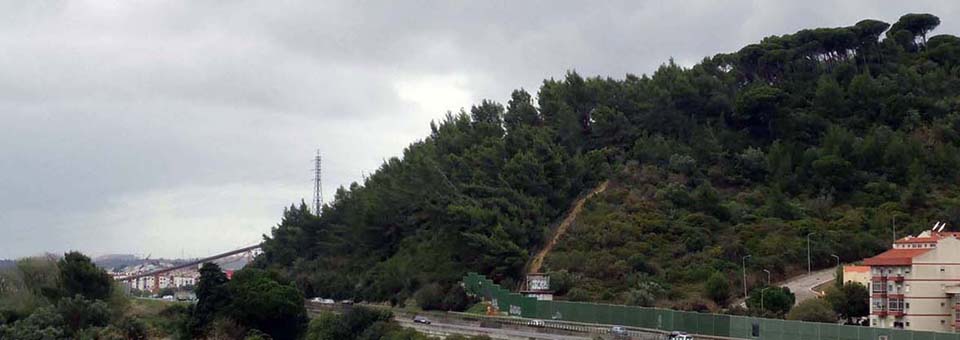
...
Alhandra. Photo taken
towards South where the lines, at their East side, reach the the
estuary of the river Tagus Adophe Thiers: "l'avant garde poursuivit
jusqu'au pied des hauteurs d'Alhandra les arriére-gardes des généraux Crawfurd
et Hill, qui disparurent derrière des retranchements d'un aspect imposant" ...
The French avant guarde reached Alhandra. 18th century historian
and later French President Adolphe Thiers: "the avant garde persecuted the rear
guard of the generals Crawfurd and Hill who disappeared behind entrenchments of
impressive posture"
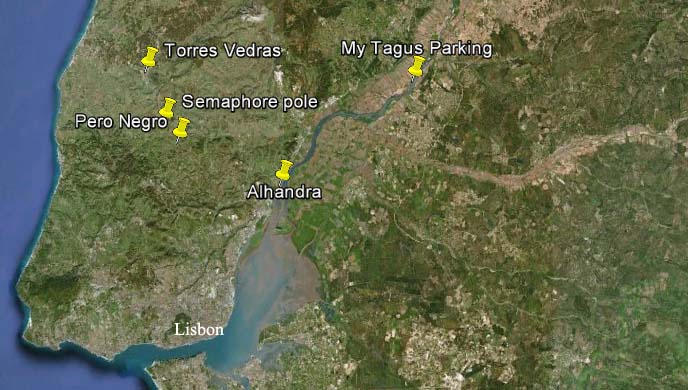
And impressive they were: a line of fortifications following
defensible natural escarpments from Alhandra over Torres Vedras to the ocean,
over 40 km long, and a second and third line behind, and nobody
knew about it, not even the British government who had not been asked for any means to
finance it. Among the records this achievement should be recognized with, the main should be
that of the biggest secret ever. Thiers: "nobody knew about it and even after
having seen it it took a reconnaissance of several days to appreciate its full
power". It happened in this week that Masséna dismounted his horse to put
his telescope on a wall and check a trench leading up to the line. Military
clothing habits of the time can leave no doubt he was recognized by the English
commander, who ordered a gunshot to be fired at a safe distance of the general,
who lifted his hat to recognize the courtesy of not having been shot at, went on
his horse and drove off to ask his staff why they had not known about this line in advance.
"Wellington has made it", it was replied. Masséna shouted, "To the Devil with
you! Did Wellington make the mountains?"

... Portugal's
A8 (IC1) highway bores itself through the Linhas de Torres Vedras ...
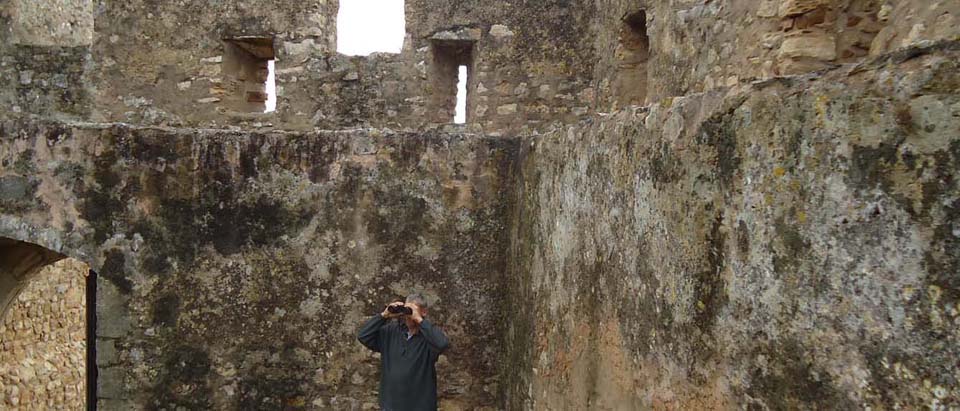
... The Castle of
Torres Verdras, quite a bit older than Wellington but, not surprisingly,
on the "line" ...
It cannot be doubted that the "line" already should have had a
history in local military rivalries. Behind it, a semaphore line got set up: 5 poles on high places
over 30 km within sight of
each other, equipped with arms to display coded signals.
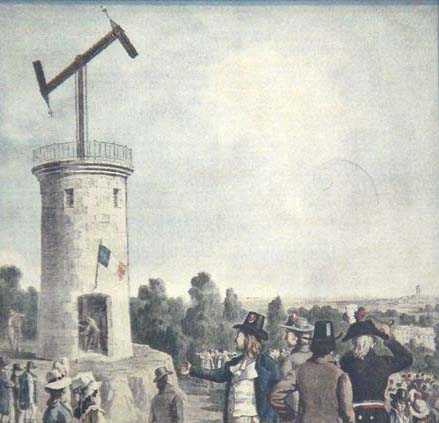
... Demonstration
of the first semaphore (Claude Chappe, early 1790's)
http://en.wikipedia.org/wiki/Claude_Chappe the
semaphore is routinely presented as an innovation of the industrial revolution
but it is not at all: it requires no 18th century technology. All you need
is some wood and the idea of symbols. The ancient Egyptian pharaohs could have
received news from all places of their entire delta in a few minutes had they
thought about it ...
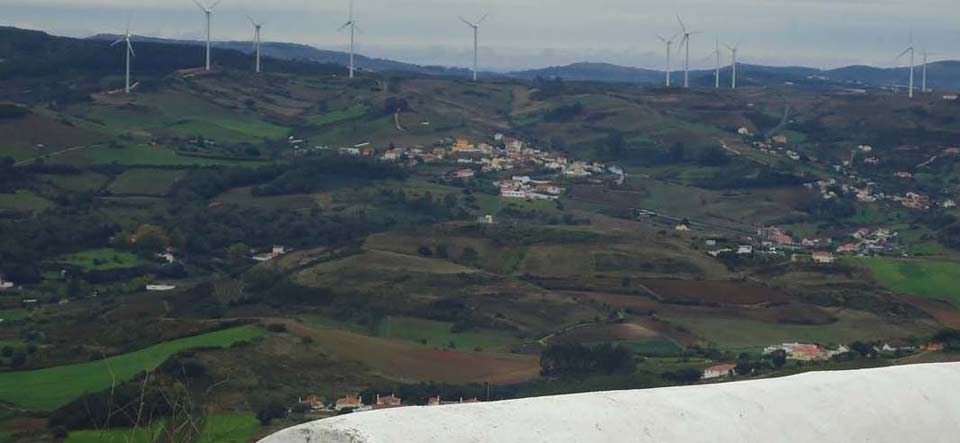
... photo taken from the semaphore at Serra
do Socorro (alt. 400m) towards Wellington's HQ village Pero Negro at 3800 m 144 degrees ...
standard modern windmills: mast 80+ m, a wing: almost 40 m.
Some say the Portuguese already had a semaphore line, others that the British
Navy established it. It allowed a message to be sent around the lines in 7
minutes, or from the HQ to any point in 4 minutes.

... pole hole left on Serra do Socorro,
respectfully covered with Perspex ...

... Serra do Socorro semaphore pole hole down left
with modern replacement up right (and scouting popular in Portugal) ...







